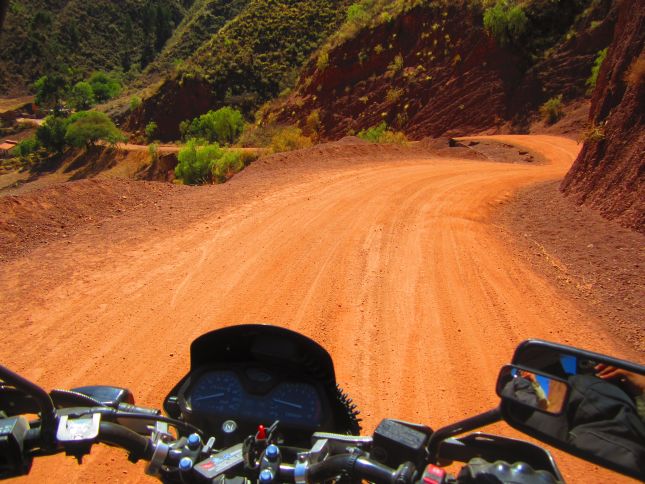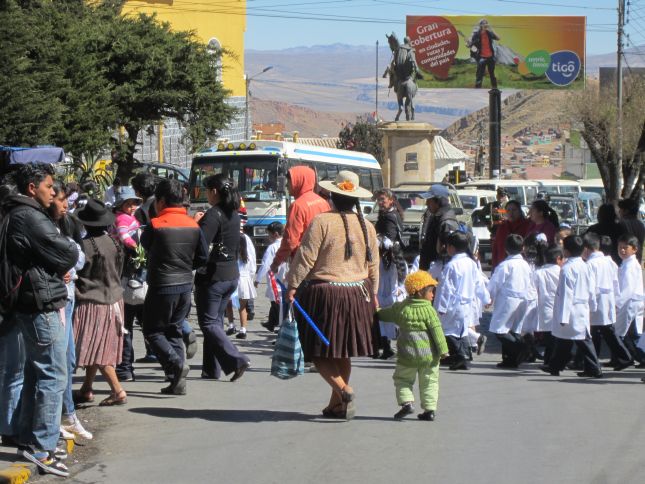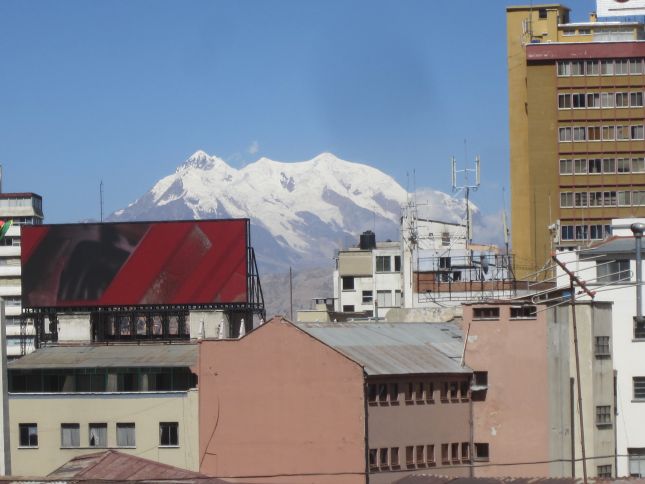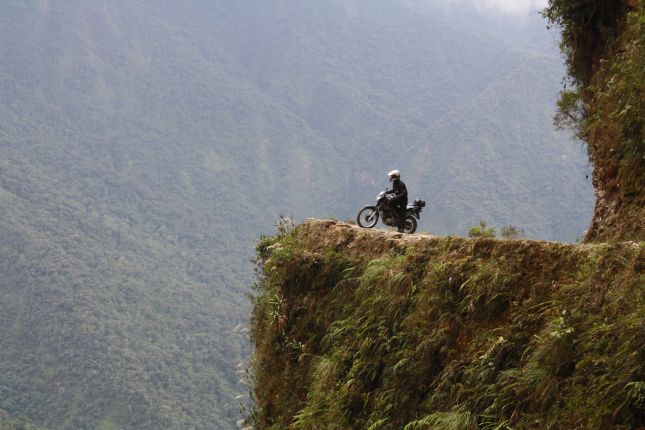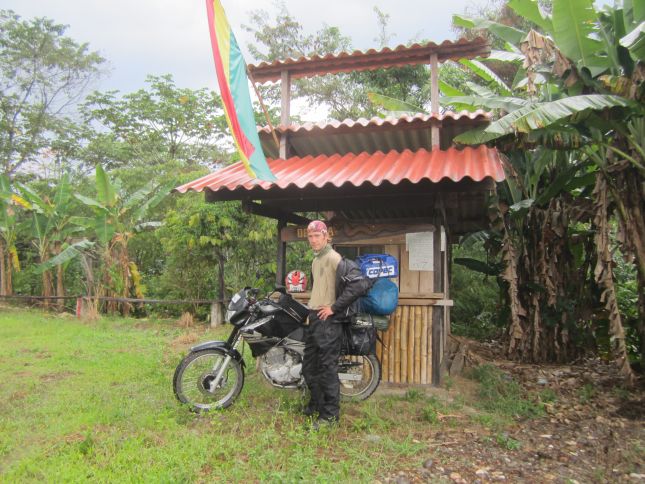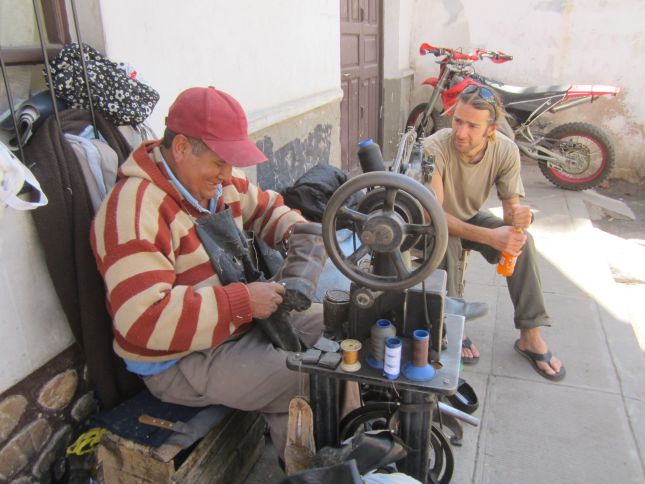
Crown Jewel of Bolivia: Sucre
TRIP INFO BOX |
|
| Route | Potosi, Bolivia – Sucre, Bolivia (RN5) |
| Distance | 164Km |
| Travel Time | 3 hours |
| Road Conditions | Good Tarmac |
| Weather | Clear, Mild |
| Terrain | Mountains & Rivers, Curvy |
| Food and Petrol | |
| Accommodation | Hostal Charcas, Sucre |
After two days we leave Potosi, not too impressed by it. We head to Sucre, 164Km all good tarmac.
We get there about 3PM and are overwhelmed by what we see. What is referred to the White City is indeed very white, groomed and cultural. It’s a beautiful place and certainly not what we were expecting. The main plaza is surrounded by beautiful old style buildings; churches, government, restaurants and cafes. The place looks rather well off, compared to other towns we’ve seen in Bolivia. And it’s full of motorbikes!
We do our methodical crawl criss-cross around the grid-iron streets in search of a hostel and opt for the Hostal Charcas, mentioned to us by the French chaps in Potosi, which we manage to negotiate for 120/night. The rooms are good, clean, towels provided and I can park the bike in the lobby. It’s also situated right opposite the Mercado Central, which is very central. right near the main plaza.
This man runs a tour agency in the hostel building. We struck up a good rapport and he was deeply sad to see us go. Ciao amigo!
The Mercado Central is a great place to visit, especially in the morning. They have everything from bread, dairy, vegetables and spices, to any bits and pieces you may need in your supplies, such as soap, make up, foot powder and shoe polish. (Here we find the best bread in Bolivia, but even so, bread doesn’t seem to be their strong-point.)
It’s also a very cost-efficient place to buy foodstuffs or eat out and definitely worth the experience. In the day the upstairs market sells delicious soups and lunches and on the ground floor you can get a lip-smacking Chorizo sandwiches and fruit smoothies. At night the upstairs food market opens, where dozens of stalls will compete for your custom, selling burgers, chicken soup, lomitos and, something you should at least try once, a Pailita, which is a combination of beef, fries, egg, vegies and pickles.
There is a certain inherent risk eating here and many travellers have been known to end up with a dicky stomach after eating here – we did after eating at a burger stand for the third time in a row. However for the most part I think it’s safe (we ate Pailitas for about a week without trouble) and should be tried at least once!
On our first night we find a classy resto-bar one street up from the Plaza called Florin. As we sit at the shiny wooden bar in this Dutch-owned place, drinking a pint-mug of tap beer we find ourselves enchanted, trying to remember when the last occasion was when we sat at a proper bar, drinking beer out of a mug, with well dressed people and western music playing around us. We can’t wipe the smile off our faces.
As the night moves on we get talking to an English (part-Turkish) expat named Jem, who tells us about a guy named Paul, who himself motorbiked through South America and may have good advice to offer. Not long after Paul himself arrives. We into a long conversation about motorbiking and as we tell him our story of mechanical woes along the way, he really empathizes with us and starts to pep us up. “You’re riding a motorbike through South America, this is an amazing trip, you’ve had some bad luck and it’s discouraged you. This isn’t acceptable. You can’t let things get you down, this your great adventure, c’mon, you have be positive, go with the flow, absorb the good energy, enjoy it!”
He recommends we visit a mechanic in town called Niki (his shop’s called MotoCar). He’s probably the best bike mechanic in the country and works on all Paul’s bikes. “Go to Nicky tomorrow and tell him your story. He’ll sort your bike out so you’ll be set for your journey with confidence, and it isn’t going to cost you a fortune.” We meet a few others of the local bike enthusiasts crew, all of them really nice folks and all of them recommending a visit to Niki. We have a good night out, spend far too much money on drink and go home feeling happy and encouraged to go on with our mission across the continent.
Two mornings later we visit Niki from MotoCar (Benito Moxos #99; Tel:6439169). He’s got a very professional way about him, very business-man-like and in technical terms very much like an engineer. He takes a screwdriver, puts the tip to various parts of my running engine and presses the grip against his ear like a stethoscope, to identify where the unusual sounds are coming from. He suggests a few ideas and I agree to return on Monday morning so he can revise the clutch, timing chain, valves, carburetor, for which he quotes 200 Bolivanos for his labour, any parts excluded.
To cut a long story short, he identifies the following:
– The tensioner is completely stuffed. The guy from Firma Motos in Calama, Chile completely wrecked it with his manual tensioning workaround and actually tensioned the bolt so much that the front side of the tensioner was cracked and breaking into pieces!
– The timing chain has reached it’s service limits and, combined with the result of the damaged tensioner, has caused the chain to vibrate well out of its normal range, causing scratching on some of the inner engine block surfaces and abrasion of the rubber chain guides, causing rubber shavings build up in the primary oil filter.
– Also the timing of the valves is not optimal nor consistent. (a result of the bad timing chain or incompetence of Calama Firma Motos)
– The black colour on the spark plug suggests that the engine has been running lean. This could be the carbutation system but my engine oil level is currently too high, which could have caused excess oil to reach and clog the air filter. (The mechanic in Calama installed 2.2 litres of oil, claiming this was necessary when replacing the oil filter – INCORRECT!)
– The clutch feel is not optimal. All clutch plates are ok but the springs on the clutch basket are a little worn i.e. compressed. Clutch baskets are costly but he re-calibrates the springs by expanding them using a mallet and screwdriver.
The bike is at Niki’s for two days. I watch all the work as usual. I’m impressed. The very first thing he does is send for the bike’s service manual and refers to it at every step along the way, confirming that all parameters are set to the recommended factory specifications.
The timing chain is replaced, the primary oil filter, air filter (no oil in the air filter thankfully) and spark plug replaced. The carb is dismantled and cleaned thoroughly. Valves are re-set – this time to 11 and 13 um, right in between the minimum and maximum service limits. A good condition replacement timing chain guide is installed, and of course a replacement tensioner.
Several of the local bike enthusiasts pop around, like Henry and Gustavo we met in Florin, but also some others including an American chap named Fletch, who’s been in Sucre for a month waiting for a new piston to arrive from home for his re-bored KLR. Probably the most unusual acquaintance made here though, is the German Shepherd guard dog, who is addicted to Coca Cola!
By the time the work is done, the bike sounds a lot better and runs much calmer than before. Clutch and gear operation is smooth as silk. Over all I am pleased, however I am still hearing that deep-down gnashing noise of metal on metal. Niki finally figures that one out: my proud customized aluminium bash-plate! It’s directly bolted to the bike chassis, causing the vibrations of the engine to transmit right though to it and resonate like the body of an instrument!
The whipping noise still comes up, but Niki believes this to be the friction of the timing chain against its guides, nothing to worry about. I don’t think I agree with him about this but I’m not going to get the engine dismantled again in hope of proving the point. As far as I’m concerned she’s been checked out as much as can be and come off with a clean record, so she’s just a noisy bike.
I also find out why my engine oil level has been so hard to maintain accurately. The guide, as well as most mechanics and bikers, advise running the engine for differing lengths of time and then checking it. I’ve heard so many different opinions by now. But with this bike, if you let it run in neutral and don’t let the engine turn in gear for a bit, it seems the oil pump doesn’t circulate the oil up into the sump properly and therefore the oil level will not show correctly – mostly too low. Now I let it warm up a few minutes, ride it around the block and I have a good reading. Annoying because this totally conflicts with the statement in the bike’s handbook.
The total bill comes to around 750 Bolivanos, that includes the work, the timing chain and tensioner, chain guide, oil filter and spark plug. Not too bad I think. While I’m at it, I ride to a place called Camel Repuestos a bit further down Av Jamie Mendoza, to make use of the advantageous hardware costs in Bolivia and get myself some spare heavy duty tyre tubes (140BOB each), chain lube (70BOB) and an emergency puncture kit (70BOB). I also get MotoCar’s guys to clean my dirty chain and I inject the Slime puncture protection into my current tubes. I also review the cigarette lighter adapter and its cable for short circuits but find nothing.
Work done, the next few days we take the bike for some trips around the area to test her out. A trip to the Sucre dinosaur park is interesting but not really worth the entrance fee. However we head out a couple of times to the valleys surrounding the Maragua volcanic crater and enjoy some great dirt riding and some of the most extraordinary scenery yet! We actually head out there in search of some petrified dinosaur footprints, but we never find them, unfortunately.
Sucre is a place you can easily get comfortable. It’s a pretty town, lots of nice places to eat, drink and visit. People are friendly and especially in the service businesses, they’re a lot more professional than anywhere else in Bolivia we’ve experienced.
There’s also a handful of European expats either just living there or running a business, as well as a constant stream of foreign travellers, so it’s easy to find yourself in familiar conversation. Add to that a great bike mechanic and lots of bikers and you’re on to a winner. 😉
Fletch, another crazy adventure biker we met here, (happily) stuck in Sucre with mechanical issues.
For me one of the highlights here in Sucre is going to a street-side cobbler to get mine and Ebru’s boots repaired. This man used century-old tools to mend our shoes into a better state of being than when they were originally bought! Manufacturers these days rely on glue to hold stuff together because they’re too cheap and lazy to produce anything that’ll last. When I see people like this at work, skilled with their hands, fixing or making things the old fashioned way, it fills me with great respect. In Bolivia, turns out, there’s plenty of this around. They can fix anything, nothing is thrown away as is the case in our wasteful “first world”. They are in possession of skills that we have long forgotten. And of course this is intentional and great for business: If you have a load of useless folk that can’t produce anything themselves you can sell them what they want and name your price.
I watch carefully how the man mends my boot. Genius. Skills like these could be of great value to me on our adventure when things get damaged. With the right tools of course… time to start looking. 🙂
We end up staying for about two weeks, which luckily includes the Bolivian independence day, and are sad to leave. Thanks to all those lovely folk in Sucre whose company made the stay so enjoyable and also to those biking folks, especially Paul, Gustavo, Henry and of course Niki from MotoCar, for offering us advice and help with our bike issues and giving us the much-needed dose of encouragement and confidence to continue our trip in high spirits.
Top recommendations:
– Corn soup for lunch from the day food market (3 BOB)
– Pailita for dinner at the night food market (12BOB)
– Best bars: Florin, Amsterdam
– Best food: Biblio Cafe (Calle Nicolas Ortiz #50), Pizza Napolitana (Plaza), Mercado Central
– Best coffee: Florin (http://www.florinsucre.com/), Biblio Cafe (Calle Nicolas Ortiz #50)
